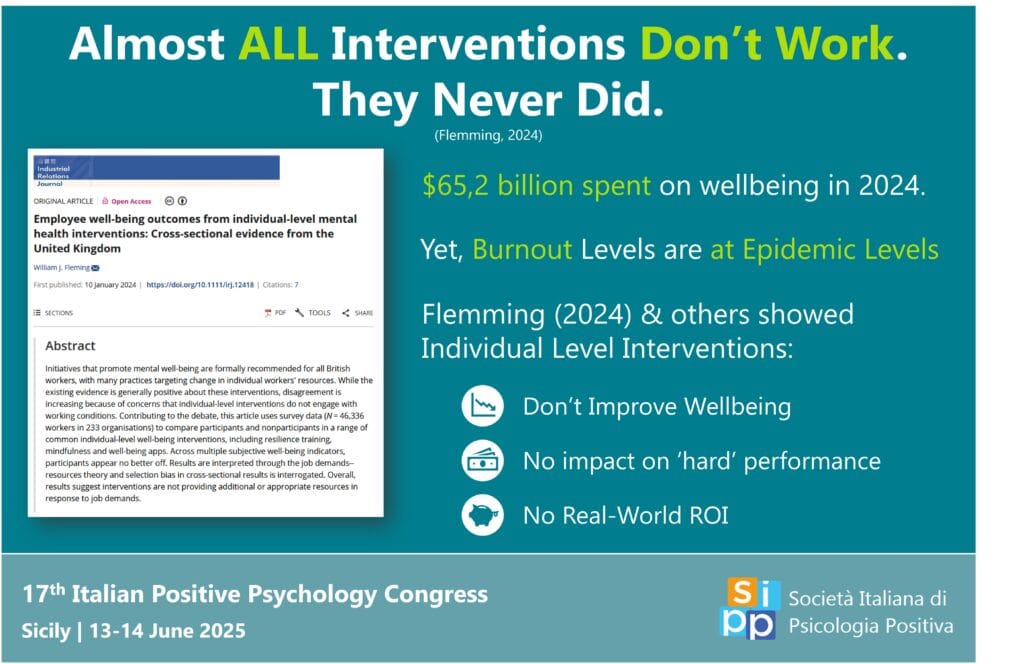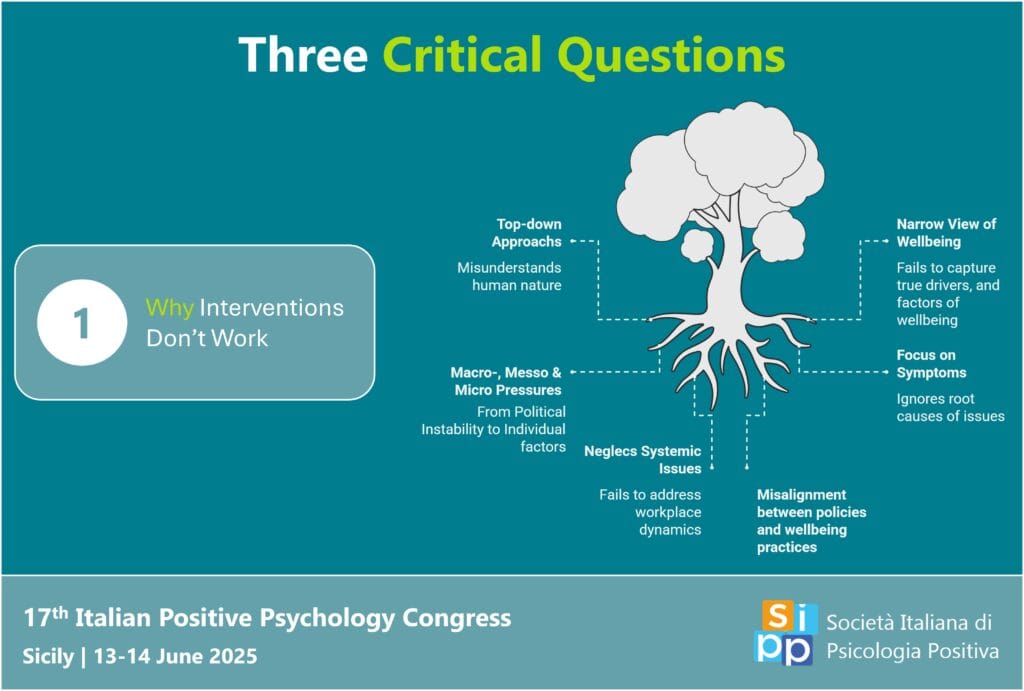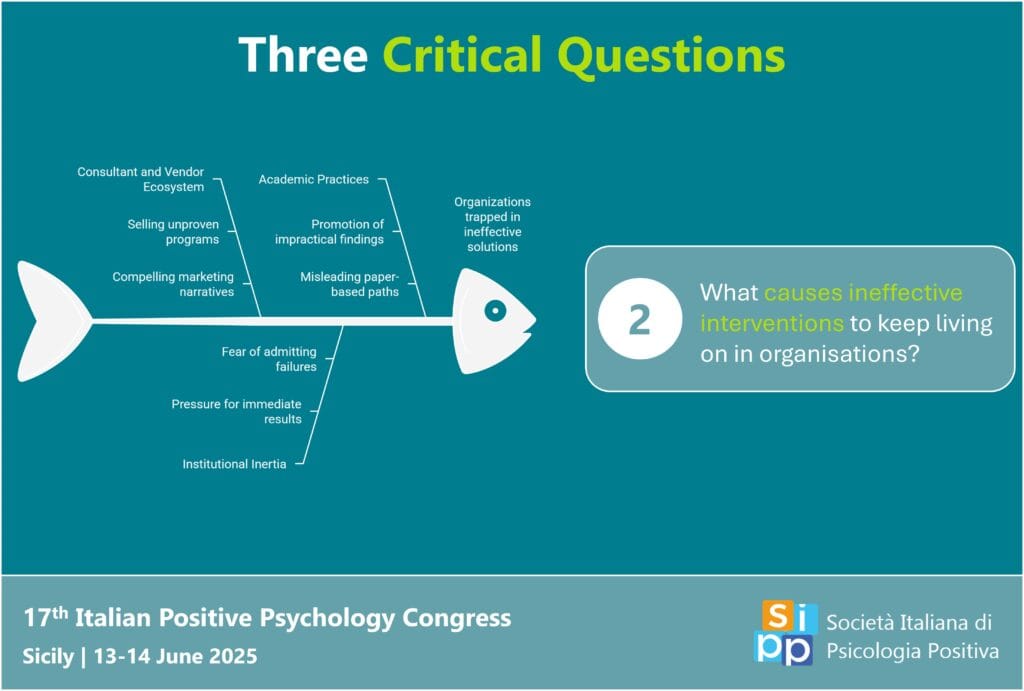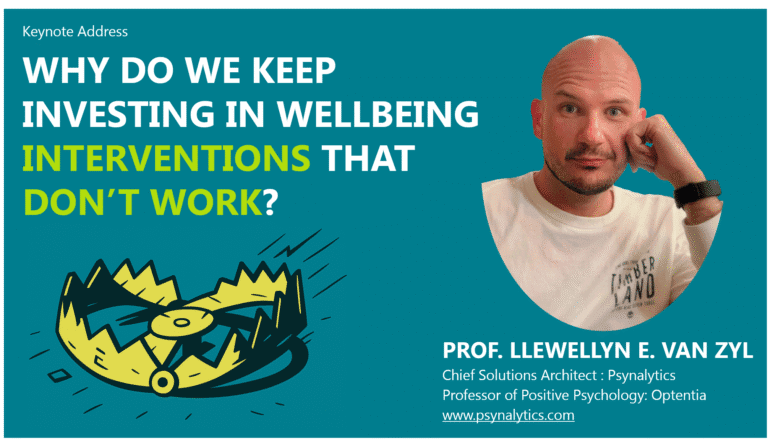KEYPOINTS
Summary: We’re pouring billions into employee wellbeing programs, yet workers worldwide are drowning in burnout and anxiety. This piece examines why many current approaches fall flat and how we can create real, lasting change.
Five Key Take-Home Messages
- Most individual-level wellbeing initiatives focus on symptoms, not causes
- One-size-fits-all wellness fixes often neglect deeper systemic workplace issues
- There’s an entire industry profiting from short-term, quick-fix solutions
- Certain academic findings don’t always hold up in real-world settings
- Truly effective interventions address the root of workplace distress holistically
Why You Should Care: Organizations are risking massive resources on programs that offer little measurable benefit, all while employee stress keeps climbing. By tackling the deeper causes behind workplace dissatisfaction, HR and psychology professionals can revolutionize not just ROI, but human lives.
Introduction
Have you ever felt that nagging disconnect between the massive sums invested in employee wellbeing and the stark reality of a workforce still teetering on the brink of burnout? It’s like seeing ads for lavish wellness apps everywhere, only to glance at your colleague who’s been working weekends for months. I’ve seen it too, and it’s unsettling.
In 2024 alone, organizations spent about $65.25 billion on mindfulness training, resilience workshops, and every app imaginable that promised to soothe away our anxiety. By 2026, that investment is projected to skyrocket to $94.6 billion and eventually surpass $102 billion. The reasoning sounds sensible: Happy employees should be more engaged, healthier, and—by extension—more productive. Yet, here we stand amid a deepening mental health crisis, caught in a loop of record burnout levels and unprecedented job dissatisfaction.

So why is this happening if everyone’s seemingly trying so hard? According to Flemming’s 2024 study, these costly programs seldom show real, lasting improvements in wellbeing or organizational performance. It’s a stark warning shot: We’re doubling down on methods that treat stress like a personal weakness rather than a structural issue. Clearly, just throwing money at the problem (and calling it “wellness”) doesn’t make it go away.
To understand this, we have to ask ourselves three critical questions:
Why do wellbeing interventions fail?
Organizations often lean on top-down wellbeing agendas that barely scratch the surface of what makes people truly thrive. I’ve sat in countless HR meetings where the conversation veered toward “mindfulness scores” or hastily assembled self-report surveys. That’s part of the problem. Measuring only a narrow slice of the employee experience neglects the complex social and systemic issues shaping everyday work life. If the root causes—like unrealistic workloads, abrasive leadership cultures, or organizational misalignment—aren’t addressed, why would we expect employees to magically transform via a meditation app?

What causes ineffective interventions to keep living on in organisations?
Let’s take a closer look at the booming industry built around these interventions. It’s fueled by consultants with polished proposals, academic citations, and stories of short-lived success. There’s nothing wrong with making a profit—except when these solutions ignore the bigger structural problems that keep stress levels soaring. The reality is that many organizations feel desperate for immediate results. They want stress to vanish by the next quarterly review, so they invest in anything that promises instant improvement. Combine that with the fear of admitting earlier efforts didn’t work, and you have the perfect environment where flashy but empty promises thrive.

How can we design interventions that work?
There’s a better way. We can design initiatives that understand both the subjective (how employees feel) and the objective (workplace policies, leadership styles, resource distribution). From watching truly effective teams, I’ve learned that a holistic approach operates like an ecosystem—everything affects everything else. When an organization rethinks workload distribution, invests in genuine peer support, and aligns its policies with what employees genuinely need, wellbeing improvements follow naturally.
Bottom-up strategies do more than just sprinkle relaxation tips on top of chronic stressors. They reframe wellbeing as something woven into the everyday fabric of work, from how leaders set priorities to how conflicts are resolved. In this model, you’re not just addressing fleeting symptoms. You’re changing the environment that gave rise to those symptoms in the first place.

A Call for Meaningful Change
It’s time to stop admiring the glossy veneer of yet another stress management workshop and start asking harder questions about what’s happening beneath that veneer. By daring to question the status quo, we can build workplaces where employees truly flourish rather than merely cope. Whether you’re at the helm of a company or part of a small team, it begins with acknowledging that employee wellbeing is more than a line item on a budget. It’s an ongoing commitment to redesigning the very structures of work to make people’s daily lives healthier, more meaningful, and more satisfying.
So, the next time you hear about a shiny new mindfulness app sweeping your industry, remember: The real solution might not be another “quick fix.” It might involve rethinking leadership behaviors, team cohesion, or even the deeper mission of your organization. That’s where lasting transformation grows—and that’s what we should be championing if we genuinely want to see a future where wellbeing is not just another corporate trend, but a measurable and deeply felt reality for everyone.that truly support human flourishing – not just on paper, but in practice.
🔓 If you care about building healthier workplaces — or if you’ve ever asked yourself, “Is this really working?” — I hope you’ll join me.
If you want to know more, why not join me at my Keynote Address on the topic at the 17th annual Italian Conference on Positive Psychology, in Sicily:
🎤 Keynote: Why Do We Keep Investing in Wellbeing Interventions That Don’t Work?
📍 Positive Psychology Congress | Italy | 13–14 June 2025
References
Fleming, W. J. (2024). Employee well‐being outcomes from individual‐level mental health interventions: Cross‐sectional evidence from the United Kingdom. Industrial Relations Journal, 55(2), 162-182.





